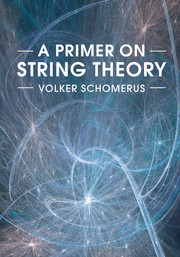Book contents
- Frontmatter
- Contents
- Preface
- 1 Historical Introduction and Overview
- Part I Strings in Flat Backgrounds
- Part II Strings in Curved Backgrounds
- 13 Introduction to Conformal Field Theory
- 14 Modular Invariants and Orbifolds
- 15 Closed Strings on the 3-Sphere
- 16 CALABI-YAU Spaces
- 17 CALABI-YAU Compactifications
- 18 String Dualities
- 19 Gauge/String Dualities
- 20 AdS/CFT Correspondence
- Bibliography
- Index
18 - String Dualities
from Part II - Strings in Curved Backgrounds
Published online by Cambridge University Press: 05 July 2017
- Frontmatter
- Contents
- Preface
- 1 Historical Introduction and Overview
- Part I Strings in Flat Backgrounds
- Part II Strings in Curved Backgrounds
- 13 Introduction to Conformal Field Theory
- 14 Modular Invariants and Orbifolds
- 15 Closed Strings on the 3-Sphere
- 16 CALABI-YAU Spaces
- 17 CALABI-YAU Compactifications
- 18 String Dualities
- 19 Gauge/String Dualities
- 20 AdS/CFT Correspondence
- Bibliography
- Index
Summary
The last few chapters of this book deal with the vast subject of dualities in string and field theory. By the nature of its topic, our presentation will be significantly less self-contained and more descriptive. On the other hand, we hope to provide some introduction into a fascinating field of modern string theory that continues to expand.
All field and string theories depend on a certain number of parameters or couplings such as the string length ls, the string coupling gs, moduli of a compactification manifold, etc. In most cases, we cannot compute the dependence on the couplings exactly. Instead, perturbative techniques give us access to the neighborhood of some special points of the full parameter space, namely to those for which a perturbative description is known. It is difficult to determine the features of a model outside such weakly coupled regimes. On the other hand, it is certainly natural to wonder about the behavior of a theory at strong coupling. Many things can happen as we crank up one or more of the coupling constants. In particular, new fundamental degrees of freedom may show up, as it is the case, e.g., in QCD, where strongly coupled physics is best described in terms of hadrons, while quarks and gluons are the fundamental objects at weak coupling. Our main goal in this chapter is to explore type II string theories outside their perturbative regime. Our analysis will lead us to intriguing new relations, or dualities, between various perturbative expansions of string theory.
T-Duality and Mirror Symmetry
Before we start varying the string coupling gs we shall briefly revisit one duality symmetry that we have seen before. To this end, let us go back to the case in which one coordinate of our string background is compactified to a circle of radius R. Such a direction gives rise to the following contributions to the closed string mass operator:
The first terms are associated with closed strings that move with some momentum and winding number n and w along the circular direction.
- Type
- Chapter
- Information
- A Primer on String Theory , pp. 181 - 192Publisher: Cambridge University PressPrint publication year: 2017



